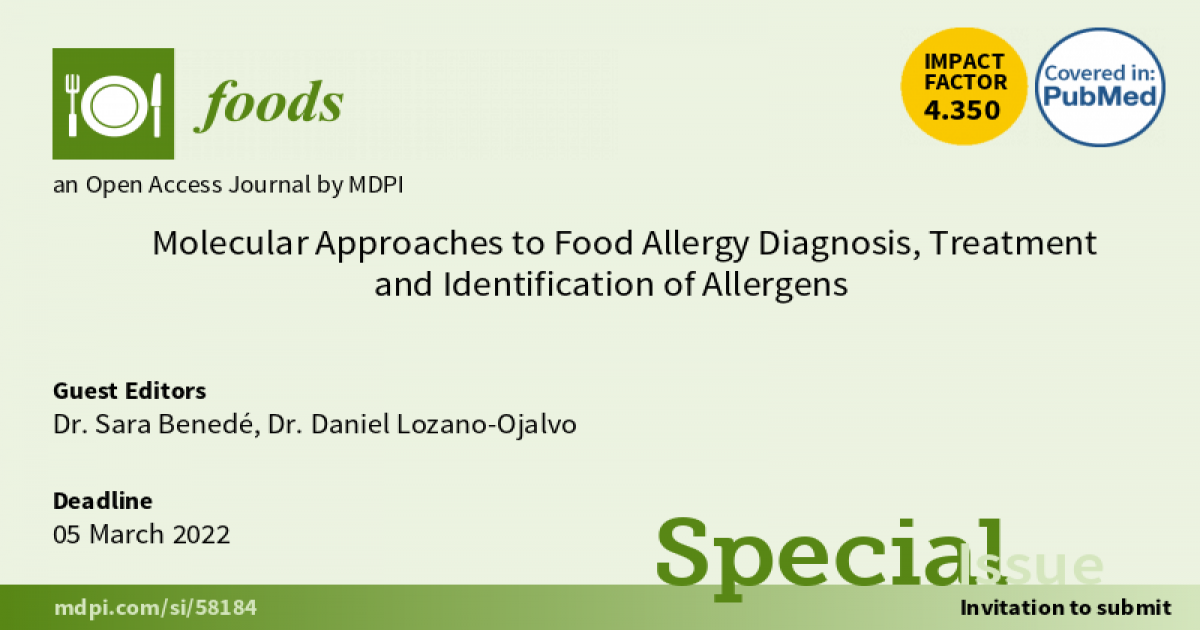Molecular Approaches for Food Protein Allergenicity Assesment and the Diagnosis and Treatment of Food Allergies
A special issue of Foods (ISSN 2304-8158). This special issue belongs to the section "Food Quality and Safety".
Deadline for manuscript submissions: closed (5 March 2022) | Viewed by 39476

Special Issue Editors
Interests: Food allergens, Food chemistry, Allergy & Clinical Immunology, Food Science & Technology
Special Issue Information
Dear Colleagues,
IgE-mediated food allergy is an increasing health problem that affects millions of persons worldwide. New developments in molecular allergology have allowed the advancement of knowledge in structure, characteristics and cellular interactions of food allergens, which could lead to a better food allergy management.
Molecular applications offer the opportunity to obtain a full panel of the sensitizing allergens in allergic patients and know the potential IgE-reactivities to cross-reactive allergens. To date there is no cure for food allergy, being the strict avoidance of the offending food the standard of treatment. However, an accurate diagnosis allows the development of specific treatments using safer and more efficacious products for allergy therapy. Molecule-based hypoallergenic preparations are the next generation of allergy vaccines. In addition, food labelling is an issue of relevance to food allergic consumers because processed foods may contain hidden allergens. Advances in allergen detection techniques allow quantifying trace levels of allergens, expanding food labelling information and protecting consumers from allergic reactions derived from cross-reactions.
This Special Issue is dedicated to the recent advances on diagnosis and treatment of food allergy as well as on identification of allergens. Therefore, articles addressing the development of innovative, reliable and rapid solutions for these matters are in the scope of this Foods Special Issue.
Regards,
Dr. Sara Benedé
Dr. Daniel Lozano-Ojalvo
Guest Editors
Manuscript Submission Information
Manuscripts should be submitted online at www.mdpi.com by registering and logging in to this website. Once you are registered, click here to go to the submission form. Manuscripts can be submitted until the deadline. All submissions that pass pre-check are peer-reviewed. Accepted papers will be published continuously in the journal (as soon as accepted) and will be listed together on the special issue website. Research articles, review articles as well as short communications are invited. For planned papers, a title and short abstract (about 100 words) can be sent to the Editorial Office for announcement on this website.
Submitted manuscripts should not have been published previously, nor be under consideration for publication elsewhere (except conference proceedings papers). All manuscripts are thoroughly refereed through a single-blind peer-review process. A guide for authors and other relevant information for submission of manuscripts is available on the Instructions for Authors page. Foods is an international peer-reviewed open access semimonthly journal published by MDPI.
Please visit the Instructions for Authors page before submitting a manuscript. The Article Processing Charge (APC) for publication in this open access journal is 2900 CHF (Swiss Francs). Submitted papers should be well formatted and use good English. Authors may use MDPI's English editing service prior to publication or during author revisions.
Keywords
- food allergy
- allergens
- allergen characterization
- diagnostic tests
- molecular therapy
- detection methods






